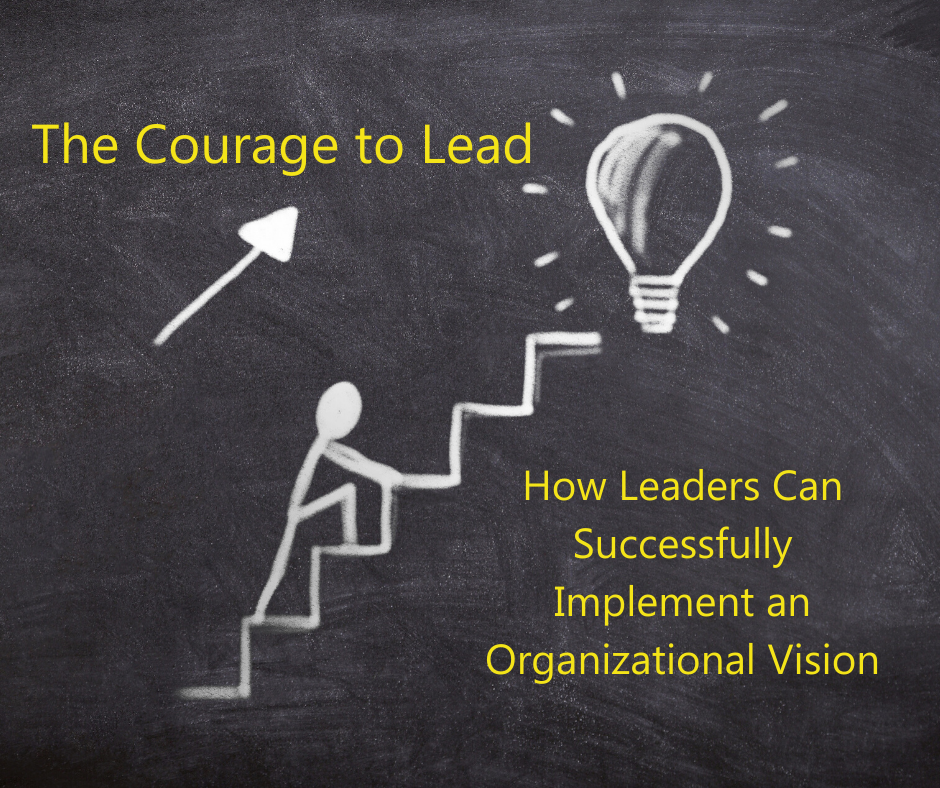 Effective leaders who expect to project a future vision they and others will follow, must first address the fears that could hinder them.
Effective leaders who expect to project a future vision they and others will follow, must first address the fears that could hinder them.
Leaders establish and communicate an envisioned future state so that others can understand and support it. A vision forecasts a possibility already imagined but yet to be designed and usefully materialized. The entrepreneur declares, “Just give me one good idea!” She may not know how to fully use it, but she will figure that part out. The gift is the idea; the work is to make it visible.
According to the Society for Human Resource Management (SHRM), “A vision statement looks forward and creates a mental image of the ideal state that the organization wishes to achieve.” Yet accomplishing this may be more complicated than it sounds because it requires not only that vision, but a kind of courage to articulate and implement that vision.
“Nothing is more powerful than an idea whose time has come.” Victor Hugo. The leaders with ideas, whose time has come, shouldn’t shy away from the power that comes with vision. These ideas whose time has come are put in the minds of specific men and women in the form of visions and at a time when they are needed.
These leaders shouldn’t shy away from the power that comes with vision. Because the power is not simply in the vision alone–it is in the carriers of the vision as well. Through them, change, improvement, recovery, correction and advancement are all made possible.
It sounds easy enough. So then what stops leaders from leading?
Develop and Articulate the Vision
It takes courage to develop and articulate a vision without knowing how it will be received. And so the leader may ask, will it be valued? Is this the appropriate time? Can it be used against me? It is natural to feel vulnerable while sharing that vision with others and exposing it to the public scrutiny of rivals or detractors. Sharing a vision can be frightening, too, if it’s a new or unfamiliar concept with little understanding of how it can work or function, or if previous ideas have been criticized.
And yet, employees within an organization yearn for effective leadership. They look forward to someone who has a better idea and elevated view of how work can be done and who has the integrity to implement it through galvanized resources.
According to The Economist, integrity remains one of the top leadership attributes. Among the qualities of integrity is authenticity.
“The supreme quality for leadership is unquestionably integrity. Without it, no real success is possible, no matter whether it is on a section gang, a football field, in an army, or in an office.” -Dwight D. Eisenhower
So what then stops leaders from leading? Insufficient belief in the vision or in their own capabilities or authority to bring it about. In a word, doubt. As a result, they ignore it or wait too late, thus losing their window of opportunity.
Although it is understandable to feel uneasiness about articulating a vision, those misgivings should be overcome since they can result in leadership paralysis.
Navigate Doubt and Fear
First, it is important to get feedback on the vision before it is implemented, as new perspectives can help to review the ideas in a different light. Keep in mind that these organizational allies not only support the vision because they respect the integrity of the one who put it forth, but, to the leaders’ credit, they want to be involved.
But carefully consider your advisors and choose them wisely: who are you going to and for what reason? Do you want affirmation? Advice? Approval? Ask yourself: “Why am I really asking this particular person? Do they have something to add to the concept?” Be sure to identify certain outcomes and actionable steps before the conversations and to carefully evaluate others’ advice after the conversations occur.
It may be easy to lose confidence if the vision is not fully embraced by the advisors, but before you abandon it, assess the feedback: ignore what is not helpful, and take the helpful advice and determine how to tweak the vision with that advice in mind.
Implement the Vision
Once a leader has received and considered initial feedback on the vision, it is time to implement it into the organization. Begin with a clear and consistent articulation of the vision so that everyone understands it.
It is possible that, even with clear understanding, the employees may resist the vision. If there is organizational pushback once the vision is implemented, try these steps:
- Communicate extensively. For instance, create a Question and Answer document for the team in which you clearly outline the mission and process. This allows the message to be consistent.
- Make sure there is a clear organizational plan for implementation.
- Identify the champions: look for the movers and doers
- Task the doers with those activities that will yield results that directly impact what the organization is trying to accomplish.
- Create a collaborative environment in which employees can honestly respond to the implementation. Welcome their improvements to the plan and emphasize the collaborative process: what are their experiences suggesting about the vision?
These steps may make it seem easy, but, in truth, the process of implementation can be fraught and can naturally lead to fear or self-doubt.
Yet authenticity and integrity are essential as leaders and lead to ethical work practices. Employees appreciate transparency, authenticity, and consistency. So even if there is confusion or resistance, if you have built up trust and goodwill within the organization, the resistance can be overcome.
Through this entire process, the leader, possessed by a vision, triggers improvement and empowerment. This leader should not be afraid of the vulnerability preceding the victory.
How do you get there? Let us be your collaborators. As business consultants, we at Bellewether can help strategize and create the structure for a successful implementation for your vision and provide clear measurements for success. We can share our expertise with you, in whatever visionary stage you are in.






